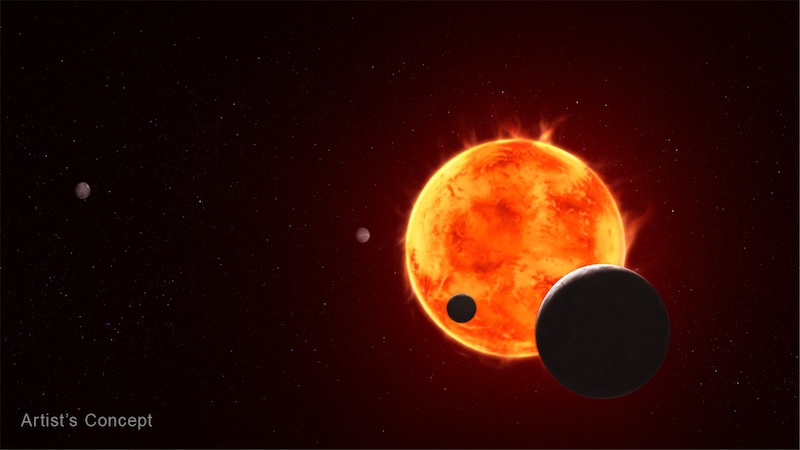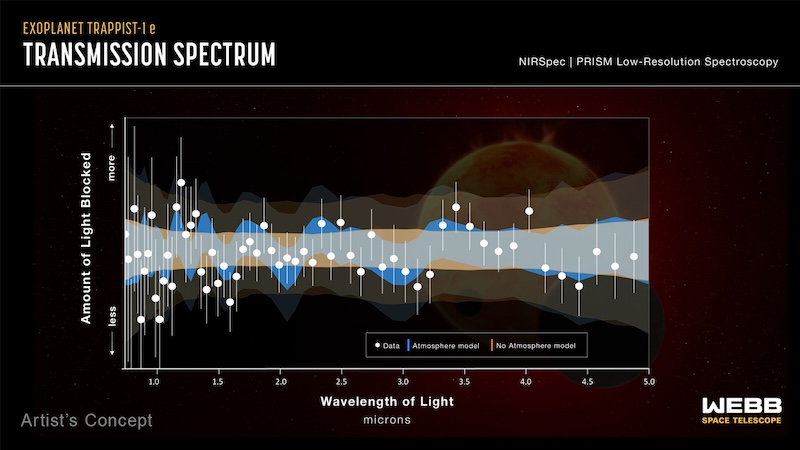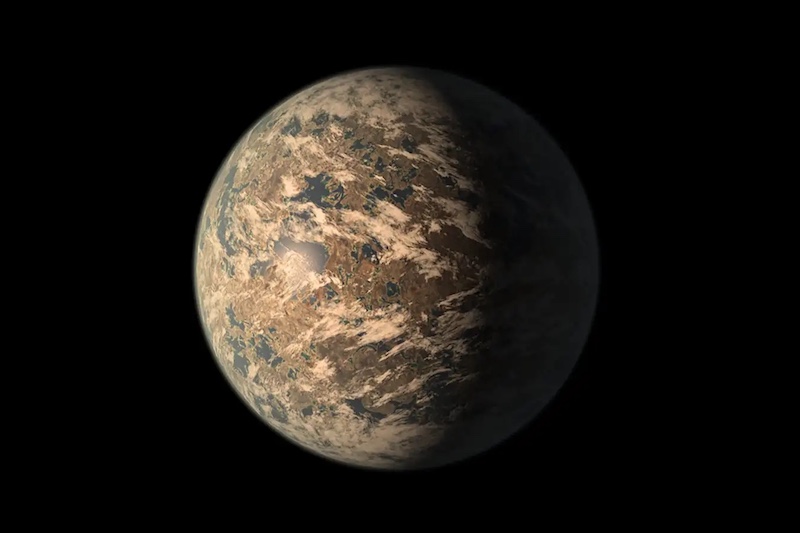Now Reading: Exoplanet TRAPPIST-1e: New hints of a habitable world?
-
01
Exoplanet TRAPPIST-1e: New hints of a habitable world?
Exoplanet TRAPPIST-1e: New hints of a habitable world?


- TRAPPIST-1e is the 4th of seven planets in the TRAPPIST-1 planetary system, about 40 light-years away. It is a rocky world similar in size to Earth. Does it have an atmosphere? Could it be habitable?
- First results from the James Webb Space Telescope hint at a possible atmosphere of nitrogen and methane. But more observations are needed to know for sure.
- TRAPPIST-1e is in the habitable zone of its star. Having an atmosphere would mean it could possibly have liquid water on its surface.
An atmosphere on exoplanet TRAPPIST-1e?
Scientists regard exoplanet TRAPPIST-1e as one of the most – if not the most – likely of the seven TRAPPIST-1 planets to have an atmosphere and be potentially habitable. This remarkable system of planets is less than 40 light-years away. Now, two teams of researchers report the first results from observations of TRAPPIST-1e by the James Webb Space Telescope. They said on September 8, 2025, that while the planet likely no longer has a primordial atmosphere of hydrogen, there is tentative evidence for a possible secondary atmosphere. That atmosphere – if it does indeed exist – would most likely be composed of nitrogen and methane, reminiscent of Earth’s atmosphere. But it might also not have any atmosphere at all. So additional observations are needed to narrow down the possibilities.
TRAPPIST-1e orbits within the habitable zone of its red dwarf star. The habitable zone is the region where temperatures could allow liquid water to exist, if there is an atmosphere. Like the other six planets in the system, the planet is rocky and close in size to Earth.
So far, researchers have analyzed data from four transits of TRAPPIST-1e. That’s when the planet passes in front of its star, as seen from Earth. Webb can then analyze the transmission spectrum coming from the planet for clues to its composition and atmosphere.
The researchers published their peer-reviewed findings in two new papers in The Astrophysical Journal Letters on September 8, 2025. You can read them here and here.
Read more: What does habitable mean to astronomers?
? ? Seven Earth-sized worlds orbit the star TRAPPIST-1, but it is much more volatile than our sun. Scientists think the system’s fourth planet is the best candidate for maintaining an atmosphere and a habitable surface: https://bit.ly/47Pt4nh
— Space Telescope Science Institute (@stsci.edu) 2025-09-08T14:04:02.648121211Z
A monumental sign of an atmosphere on TRAPPIST-1e could be the precursor to finally finding a living world around another star
— Scientific American (@sciam.bsky.social) 2025-09-09T19:23:29.206Z
No primordial atmosphere
Although the results are still preliminary after only four transits, the researchers said TRAPPIST-1e most likely does not have any primordial atmosphere left, if it ever had one. That’s the original lightweight hydrogen atmosphere the planet formed with. Planets orbiting red dwarf stars can easily lose their atmosphere as a result of bombardment by intense radiation from the star.
But it’s still possible that TRAPPIST-1e could have a secondary atmosphere that formed later on.
A nitrogen atmosphere on TRAPPIST-1e? Maybe
So, no primordial atmosphere. But the data so far point to another – and more interesting – possibility. The planet could have a secondary atmosphere. That’s a heavier atmosphere composed of gases such as nitrogen or carbon dioxide. Those atmospheres, including Earth’s, as an example, form later on in a rocky planet’s lifetime. TRAPPIST-1e doesn’t appear to have a primarily carbon dioxide atmosphere, like Venus and Mars.
However, the researchers say that as of now, the data do fit best with a nitrogen atmosphere. Those hints in the spectrum of the planet are very small though. They are near the limits of the detection capabilities of Webb. While the spectra of the two innermost planets, TRAPPIST-1b and TRAPPIST-1c, showed flat lines, meaning likely little to no atmospheres, the spectrum of TRAPPIST-1e is almost flat, with little bumps. This hints at an atmosphere, although it is still possible that there isn’t one on this planet either. TRAPPIST-1d also showed hints of a possible atmosphere, maybe.

And methane, too?
Ryan MacDonald at the University of St. Andrews, U.K., is an author on both papers. He made some interesting comments in an article for New Scientist:
It does look like there are some bumps and wiggles in the data that, based on our atmospheric modelling, are well fit by a nitrogen-rich atmosphere, and potentially with molecules like methane.
Of all the spectra we have obtained so far of the planets in the TRAPPIST-1 system, this is the one that’s the most promising, that’s pointing towards there potentially being something there. Obviously, I’m hoping that the planet right in the middle of the habitable zone of this star has an atmosphere, because that would have incredible implications for astrobiology, our search for life and habitability.
In response to a question I posed on Bluesky, he also noted:
CH4 (methane) is the best explanation we found for the potential bumps on the spectrum. N2 (nitrogen) doesn’t have any notable absorption of its own, but we need a background gas heavier than CH4 (~ 16 proton masses) to match the data, and N2 (~ 28 proton masses) does a good job.
CH4 is the best explanation we found for the potential bumps on the spectrum. N2 doesn't have any notable absorption of its own, but we need a background gas heavier than CH4 (~ 16 proton masses) to match the data, and N2 (~ 28 proton masses) does a good job.
— Dr Ryan MacDonald (@distantworlds.space) 2025-09-09T06:56:34.587Z

Is exoplanet TRAPPIST-1e a habitable world?
If the nitrogen and methane atmosphere really is there, then TRAPPIST-1e could potentially be habitable. If temperatures were warm enough, liquid water might be able to exist on its surface. And if there is any water, it could be anything from a global ocean to a small sea surrounded by ice.
And although the atmosphere likely isn’t dominated by carbon dioxide, the researchers said there could still be enough to have a greenhouse effect, warming the planet.
Nikole Lewis at Cornell University in Ithaca, New York, is also an author on both papers. She said:
A little greenhouse effect goes a long way. TRAPPIST-1 is a very different star from our sun, and so the planetary system around it is also very different, which challenges both our observational and theoretical assumptions.
Scientists estimate the TRAPPIST-1 system to be 7.6 billion years old, significantly older than our own solar system (4.6 billion years). So maybe, just maybe, life was able to begin on one of these enigmatic worlds.
Only further observations will help determine just what atmosphere TRAPPIST-1e has, if any. Luckily, scientists are planning at least 15 more observations over the next year or so, so stay tuned!
Bottom line: The first analysis results from the James Webb Space Telescope indicate that exoplanet TRAPPIST-1e might have an atmosphere of nitrogen and methane.
Source: JWST-TST DREAMS: Secondary Atmosphere Constraints for the Habitable Zone Planet TRAPPIST-1 e
Read more: An atmosphere on TRAPPIST-1 d? New observations say maybe
Read more: Innermost TRAPPIST-1 exoplanet is hot and airless
The post Exoplanet TRAPPIST-1e: New hints of a habitable world? first appeared on EarthSky.
Stay Informed With the Latest & Most Important News
Previous Post
Next Post
-
 01From Polymerization-Enabled Folding and Assembly to Chemical Evolution: Key Processes for Emergence of Functional Polymers in the Origin of Life
01From Polymerization-Enabled Folding and Assembly to Chemical Evolution: Key Processes for Emergence of Functional Polymers in the Origin of Life -
 02Two Black Holes Observed Circling Each Other for the First Time
02Two Black Holes Observed Circling Each Other for the First Time -
 03How New NASA, India Earth Satellite NISAR Will See Earth
03How New NASA, India Earth Satellite NISAR Will See Earth -
 04Thermodynamic Constraints On The Citric Acid Cycle And Related Reactions In Ocean World Interiors
04Thermodynamic Constraints On The Citric Acid Cycle And Related Reactions In Ocean World Interiors -
 05Φsat-2 begins science phase for AI Earth images
05Φsat-2 begins science phase for AI Earth images -
 06Hurricane forecasters are losing 3 key satellites ahead of peak storm season − a meteorologist explains why it matters
06Hurricane forecasters are losing 3 key satellites ahead of peak storm season − a meteorologist explains why it matters -
 07Binary star systems are complex astronomical objects − a new AI approach could pin down their properties quickly
07Binary star systems are complex astronomical objects − a new AI approach could pin down their properties quickly




















